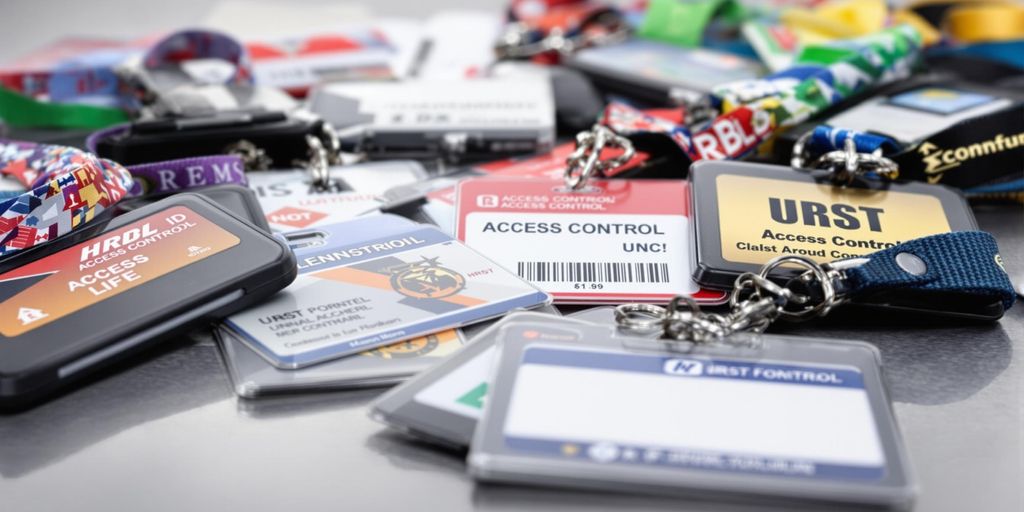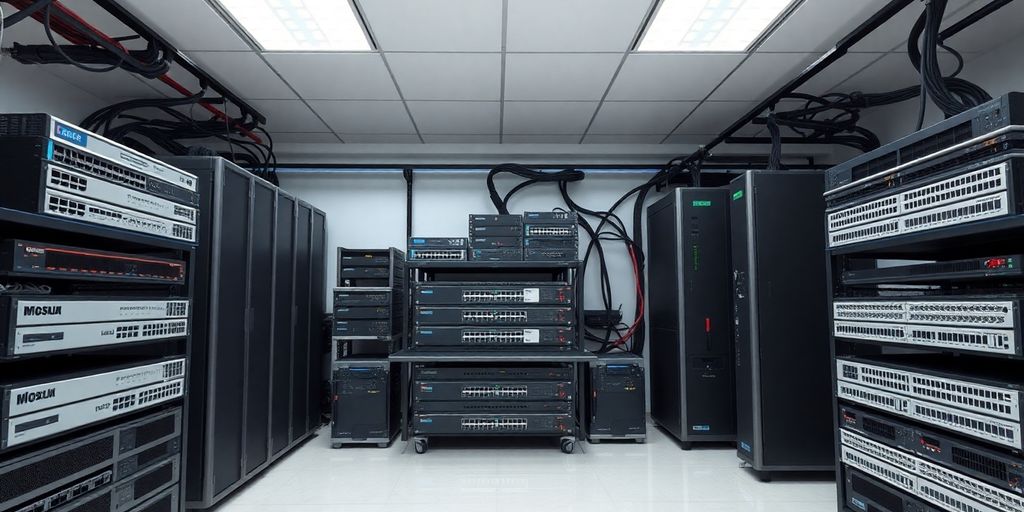Access control badging supplies are a big deal for businesses wanting to up their security game. We’re talking about those ID cards you swipe or tap to get into places. They’re not just about keeping people out but making sure the right folks get in. From simple plastic cards to fancy encrypted badges, there’s a lot to consider. Let’s dive into what makes these systems tick and why they’re essential for modern security setups.
Key Takeaways
- Access control badges are vital for securing business premises.
- Different types of badges offer various levels of security and convenience.
- Advanced badges can integrate with other security systems for added protection.
- Visitor and employee badge systems serve different purposes but are equally important.
- Choosing the right badge system involves assessing security needs and available technology.
Understanding Access Control Badging Supplies

Key Components of Badge Systems
Access control badge systems are all about managing who gets in and out of a place. These systems mainly consist of three parts:
- Badges: These are like ID cards. They usually have a chip or magnetic stripe that holds the user’s info, like name and security level. Some are even RFID tags that make scanning a breeze.
- Card Readers: These gadgets read the badges. They check the info on the badge and decide if you can enter or not. They’re like bouncers at a club but for buildings.
- Locks: The locks are either magnetic or electronic. They work with the card readers to open doors for the right people and keep others out.
Types of Access Badges
Access badges come in different flavors, depending on what you need:
- Standard ID Badges: These are your regular badges with a photo and basic info.
- Smart Badges: These have chips that store more data and can even do more than just open doors.
- Biometric Badges: These are high-tech and use fingerprints or other biometrics for added security.
Role of Card Readers in Security
Card readers are the gatekeepers of access control systems. They ensure that only authorized folks get through. They can be simple or advanced, depending on the security needs. Some even work with RFID technology, making them super efficient and reliable.
Understanding the components of badge systems is crucial for setting up a secure access control environment. Each part plays a role in ensuring that only the right people have access to certain areas. This balance of technology and security is what makes badge systems a staple in both small businesses and large corporations.
Choosing the Right Badge System for Your Business
Assessing Security Needs
When it comes to picking a badge system, the first thing is to figure out what kind of security you actually need. Are you a small office just trying to keep track of who comes in and out? Or maybe a big corporation needing to secure sensitive areas? Understanding your specific security requirements is the foundation of choosing the right system. Think about the number of access points you have and the level of security each one needs.
- Determine the number of employees and visitors using the system.
- Consider the sensitivity of areas needing protection.
- Evaluate the current security measures in place.
Evaluating Technology and Features
Once you know your needs, it’s time to look at the tech. Badge systems come with all sorts of bells and whistles these days. Some are simple, while others integrate with visitor badge systems that enhance efficiency. Here’s what you might want to consider:
- Type of Badges: Magnetic stripe, RFID, or smart cards?
- Compatibility: Does it work with existing systems?
- Advanced Features: Look for encryption, biometric integration, or mobile compatibility.
Installation Considerations
Installing a badge system isn’t just plug-and-play. You need to think about how it fits into your building’s layout and your daily operations.
- Infrastructure Requirements: What kind of wiring or network setup is needed?
- Professional Installation vs. DIY: Sometimes it’s worth paying for a pro.
- Training and Support: Ensure your team knows how to use the system effectively.
A well-chosen badge system not only secures your premises but also streamlines operations, making day-to-day activities smoother and more efficient.
Enhancing Security with Advanced Badge Technology
Benefits of Encrypted Badges
Encrypted badges are like your digital bodyguards. They make it tough for anyone to duplicate or clone your access credentials. Imagine trying to break into a vault without the right key—it’s just not happening. These badges use encryption to keep your data safe, ensuring that only authorized folks can access sensitive areas. Plus, if a badge gets lost or stolen, it can be deactivated remotely, minimizing security risks.
Integration with Other Security Systems
Modern badge systems don’t just stand alone; they play well with others. They can be integrated with existing security measures like cameras, alarms, and even security guards. This creates a layered security approach that boosts overall protection. So, when someone swipes their badge, it’s not just about opening a door—it can trigger cameras to start recording or alert security personnel to keep an eye on things.
Trends in Badge Technology
Badge technology is always on the move, with new trends popping up all the time. One big trend is the use of biometrics, like fingerprints or facial recognition, to add an extra layer of security. Another trend is mobile credentials—using your smartphone as a badge. This not only makes things more convenient but also reduces the need for physical badges. And with the rise of remote work, having flexible and scalable systems is more important than ever.
In a world where security threats evolve constantly, staying ahead with advanced badge technology is not just smart—it’s necessary. By embracing these innovations, businesses can protect their assets and ensure that only the right people have access to critical areas.
For those interested in a modern badge access control system, these advancements offer a blend of security and flexibility, making them an ideal choice for efficient entry management.
Visitor vs. Employee Badge Systems
Differences in Access Levels
When it comes to badge systems, visitors and employees have different access needs. Employees often require access to multiple areas within a facility, while visitors typically need temporary access to specific zones. Employee badges are usually personalized with photo identification and specific access rights tailored to their roles. Visitor badges, on the other hand, are often generic and provide limited access to ensure security.
Security Risks of Visitor Badges
Visitor badges, while necessary, can pose security risks if not managed properly. Since they are often generic and not linked to a specific individual, there’s a risk of unauthorized access if a badge is lost or stolen. To mitigate these risks, businesses can implement visitor badge systems that track who is entering and exiting the building, including time-stamped logs and unique identifiers for each visitor badge.
Customizing Employee Badges
Employee badges can be customized to enhance security and functionality. This customization can include adding RFID chips for contactless entry or integrating them with other security systems like time clocks or computer logins. By customizing badges, companies can ensure that employees have the necessary access while maintaining security protocols. Custom badges also help quickly identify employees, reducing the chance of unauthorized access.
Maximizing Efficiency with Badge Systems
Implementing a badge system can significantly streamline access control within an organization. By automating entry and exit points, businesses can reduce the reliance on manual checks, thus saving time and resources. A well-designed badge system simplifies the process, allowing employees to move seamlessly through secure areas. This efficiency not only enhances productivity but also minimizes the potential for human error.
Monitoring Employee Movements
Badge systems provide a reliable way to track employee movements within a facility. This tracking capability is crucial for both security and operational efficiency. By logging entry and exit times, companies can gain insights into employee attendance and workflow patterns. This data can be instrumental in optimizing scheduling and ensuring that resources are allocated effectively.
Scalability and Flexibility
One of the standout features of modern badge systems is their scalability. As a company grows, the badge system can easily adapt to accommodate more users without requiring significant infrastructure changes. This flexibility is vital for businesses anticipating growth or changes in their workforce. Moreover, advanced door badge reader systems with features like contactless credentials ensure that security measures keep pace with technological advancements.
Efficient badge systems are not just about controlling access. They’re about creating an environment where security and convenience coexist, allowing businesses to focus on what they do best without compromising on safety.
Addressing Common Concerns with Badge Systems

Dealing with Lost or Stolen Badges
Losing an access badge can be a hassle, but it’s something that needs to be addressed quickly to maintain security. The first step is to report the loss immediately to your security team. They can deactivate the badge to prevent unauthorized access. Many modern systems allow for quick deactivation and reissuance, minimizing downtime and security risks. It’s also a good practice to have a clear policy in place for employees on what to do if they misplace their badge.
Ensuring Data Privacy
Data privacy is a big concern with access control systems. These systems often store personal information, which can be a target for cybersecurity risks. To safeguard this data, it’s crucial to use encrypted badges and secure databases. Regular audits and updates to the system can help in identifying potential vulnerabilities. Training employees on data privacy practices can also go a long way in protecting sensitive information.
Offline Functionality of Badge Systems
What happens if the internet goes down? Well, many badge systems are designed to work offline, ensuring that access control isn’t compromised during network outages. These systems store access permissions locally, allowing them to function independently of an internet connection. It’s a smart move to have systems that can operate offline, especially in areas with unreliable internet service. It’s also wise to have backup power sources to keep the system running during power outages.
Future-Proofing Your Access Control System
Adapting to Emerging Trends
The world of access control is constantly evolving, and keeping up with the latest trends is crucial for maintaining robust security. One of the biggest shifts we’re seeing is the move towards advanced biometrics, which use unique physical traits like fingerprints and facial recognition to grant access. This technology not only enhances security but also reduces the hassle of managing physical badges or keys.
Another trend is the integration of IoT devices, which allows for smarter, interconnected systems. These systems can communicate with each other, providing a more comprehensive security network. For example, a door sensor can trigger a camera to start recording when it detects an unauthorized entry attempt.
Incorporating Mobile Credentials
Mobile credentials are becoming a popular choice for businesses looking to streamline access control. Instead of carrying a physical badge, employees can use their smartphones to gain entry. This not only simplifies the process but also adds an extra layer of security, as phones typically have their own security measures like passwords or biometric locks.
Switching to mobile credentials can also be more cost-effective in the long run. There’s no need to replace lost badges or issue new ones when roles change. Plus, updates to access permissions can be made instantly, ensuring that security policies are always up-to-date.
Ensuring Long-Term Security
To ensure your access control system remains effective in the long term, it’s important to choose technology that can adapt to future needs. Look for systems that offer regular software updates and have a track record of reliability.
It’s also wise to invest in a system that can scale with your business. As your company grows, your security needs will likely change. A scalable system allows you to add new entry points or integrate with other security technologies without a complete overhaul.
"Future-proofing your access control system is not just about adopting the latest technology, but also about ensuring flexibility and adaptability for whatever comes next."
Wrapping It Up: The Key Takeaways on Access Control Badging Supplies
So, there you have it. Access control badging supplies are more than just fancy tech—they’re a crucial part of keeping your business secure. Whether you’re a small shop or a big corporation, these systems help you keep tabs on who’s coming and going. And let’s be honest, in today’s world, you can’t be too careful. From badges to card readers and electronic locks, each piece plays its part in the bigger security picture. Sure, there are costs and some setup involved, but the peace of mind? Totally worth it. Plus, with tech always evolving, who knows what cool features we’ll see next? Just remember, it’s not just about locking doors—it’s about opening them safely for the right people.
Frequently Asked Questions
What are the main parts of an employee badge system?
An employee badge system usually has three main parts: the badges themselves, card readers, and door locks. Badges are like ID cards that let people into certain areas. Card readers check the badges to make sure the person is allowed in. Door locks open or stay closed based on what the card reader says.
Can access badges be used in small businesses?
Yes, access badges can be used in small businesses. They can be adjusted to fit the size and budget of the business, helping to keep the place secure.
What happens if a badge gets lost or stolen?
If a badge is lost or stolen, it should be reported right away to the security team. They can turn off the badge so it can’t be used anymore.
Are there different types of badges for visitors and employees?
Yes, visitor badges usually give temporary access and might not have personal info. Employee badges often have more access and include personal details.
Do badge systems need the internet to work?
Not always. Some badge systems can work without the internet, which means they still function even if the internet is down.
Can badges be used to get into more than one area?
Yes, some systems let you set up badges to work in different areas. This way, one badge can open multiple doors if the person is allowed to enter those places.



